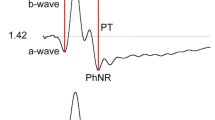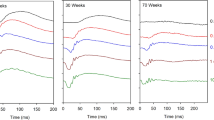Abstract
The oscilliatory potentials (OPs) of the electroretinogram (ERG) identify the high frequency wavelets which are seen riding on the top of the ascending limb of the b-wave. Despite the refinement in ERG recording techniques, which now allow for a more selective amplification of the OPs, their clinical utility still remains somewhat limited. Furthermore, while it has long been recognized that the different OPs which builds a given response are generated by distinct retinal events, amplitudes of clinically recorded oscillatory potentials are still reported using the artificial variable ‘sum of OPs (SOPs)’ which represent the sum amplitude of all the OPs identified in a given response; a method which is prone to compromise the diagnostic possibilities of the oscillatory potential response. The purpose of this report is to present a method of analysis of the OP response which is based on the relative amplitude of each OP. For the sake of clarity this report will focus on the analysis of the suprathreshold photopic OP response evoked the flash for 8.9 cd-m−2-sec in energy delivered against a rod desensitizing background of 30 cd-m−2 in luminance. The amplitude of each of the three major OPs (ie: OP2, OP3 and OP4) that normally compose this response was reported in relative units (ie: OP x /SOPs) a method shown to minimize intersubject variability and at the same time allow for each OP to be evaluated individually. With the above method I have reviewed 289 clinical OP responses collected during a 7 year interval and identified more than 10 different categories of responses of which 6 were shown to demonstrate specific anomalies for one or two OPs. The selectivity and reproducibility of my observation were confirmed on follow-up testings as well as in pedigree studies. Use of this method of OP analysis should significantly increase the clinical utility of the oscillatory potentials and also facilitate comparisons between clinical laboratories.
Similar content being viewed by others
References
Speros P, Price J. Oscillatory potentials. History, techniques and potential use in the evaluation of disturbances of retinal circulation. Surv Ophthalmol 1981; 251: 237–52.
Bresnick GH, Palta M. Predicting progression to severe proliferative diabetic retinopathy. Arch Ophthalmol 1987; 105: 810–4.
Bresnick GH, Palta M. Oscillatory potential amplitudes. Relation to severity of diabetic retinopathy. Arch Ophthalmol 1987; 105: 929–33.
Van Der Torren K, Van Lith G. Oscillatory potentials in early diabetic retinopathy. Doc Ophthalmol 1989; 71: 375–9.
Brunette JR, Lafond G. Electroretinographic evaluation of diabetic retinopathy. Sensitivity of amplitude and time of response. Can J Ophthalmol 1983; 18: 285–9.
Cobb WA, Morton HB. A new component of the human electroretinogram. J Physiol 1954; 123: 36–7.
Wachtmeister L. Basic research and clinical aspects of the oscillatory potentials of the electroretinogram. Doc Ophthalmol 1987; 66: 187–94.
Brunette JR, Lafond G. Double a-waves and their relationship to the oscillatory potentials. Invest Ophthalmol 1972; 11: 199–210.
Brown KT. The electroretinogram: Its components and their origins. Vision Res 1968; 8: 633–77.
Ogden TE. The oscillatory waves of the primate electroretinogram. Vision Res 1973; 13: 1059–73.
Karwoski C, Kawasaki K. Oscillatory potentials. In: Heckenlively JR, Arden GB, eds. Principles and practice of clinical electrophysiology of vision. St. Louis: Mosby Year Book, 1991: 125–8.
Wachtmeister L, Dowling JE. The oscillatory potentials of the mudpuppy retina. Invest Ophthalmol Vis Sci 1978, 17: 1176–88.
Wachtmeister L. Further studies of the chemical sensitivity of the oscillatory potentials of the electroretinogram (ERG). Acta Ophthalmol 1980; 58: 712–25.
Wachtmeister L. Further studies of the chemical sensitivity of the oscillatory potentials of the electroretinogram (ERG), II: Glutamate-aspartate- and dopamine antagonists. Acta Ophthalmol 1981a; 59: 247–58.
Wachtmeister L. Further studies of the chemical sensitivity of the oscillatory potentials of the electroretinogram (ERG), III; Some Ω amino acids and ethanol. Acta Ophthalmol 1981b; 59: 609–19.
Guite P, Lachapelle P. The effect of 2-amino-4-phosphonobutyric acid on the oscillatory potentials of the electroretinogram. Doc Ophthalmol 1990; 75: 125–33.
Lachapelle P, Benoit J, Guite P, Cuong TN, Molotchnikoff S. The effect of iodoacetic acid on the electroretinogram and oscillatory potentials in rabbits. Doc Ophthalmol 1990; 75: 7–14.
Lachapelle P, Blain L, Quigley MG, Polomeno RC, Molotchnikoff S. The effect of diphenylhydantoin on the electroretinogram. Doc Ophthalmol 1990; 73: 359–68.
Lachapelle P. Analysis of the photopic electroretinogram recorded before and after darkadaptation. Can J Ophthalmol 1987; 22: 354–61.
Lachapelle P. The effect of slow flicker on the human photopic oscillatory potentials. Vision Res 1991; 31: 1851–7.
Lachapelle P, Benoit J, Blain L, Guité P, Roy M-S. The oscillatory potentials in response to stimuli of photopic intensities delivered in dark-adaptation: An explanation for the conditioning flash effect. Vision Res 1990; 30: 503–13.
Lachapelle P. Evidence for an intensity-coding oscillatory potential in the human electroretinogram. Vision Res 1991; 31: 767–74.
Kojima M, Zrenner E. Off-components in response to brief light flashes in the oscillatory potentials of the human electroretinogram. Graefes Arch Clin Exp Ophthalmol 1978; 206: 107–20.
Peachey NS, Alexander KR, Derlacki DJ, Bobak P, Fishman GA. Effects of light adaptation on the response characteristics of human oscillatory potentials. EEG Clin Neurophysiol 1991; 78: 27–34.
Peachey NS, Alexander KR, Fishman GA. Rod and cone system contributions to oscillatory potential: An explanation for the conditioning flash effect. Vision Res 1987; 27: 859–66.
Gorfinkel J, Lachapelle P, Molotchnikoff S. Maturation of the electroretinogram of the neonatal rabbit. Doc Ophthalmol 1988; 69: 237–45.
Gorfinkel J, Lachapelle P. Maturation of the photopic b-wave and oscillatory potentials of the electroretinogram in the neonatal rabbit. Can J Ophthalmol 1990; 25: 138–44.
el Azazi M, Wachtmeister L. The postnatal development of the oscillatory potentials of the electroretinogram, I: Basic characteristics. Acta Ophthalmol 1990; 68: 401–9.
el Azazi M, Wachtmeister L. The postnatal development of the oscillatory potentials of the electroretinogram, II: Photopic characteristics. Acta Ophthalmol 1991; 69: 6–10.
King-Smith PE, Loffing DH, Jones R. Rod and cone ERGs and their oscillatory potentials. Invest Ophthalmol Vis Sci 1986; 27: 270–3.
Dawson WW, Stewart HL. Signals within the electroretinogram. Vision Res 1968; 8: 1265–70.
Lachapelle P, Little JM, Polomeno RC. The photopic electroretinogram in congenital stationary night blindness with myopia. Invest Ophthalmol Vis Sci 1983; 24: 442–50.
Heckenlively JR, Martin DA, Rosenbaum AL. Loss of electroretinographic oscillatory potentials, optic atrophy, and dysplasia in congenital stationary night blindness. Am J Ophthalmol 1983; 96: 526–34.
Miyake Y, Yagasaki K, Horiguchi M, Kawase Y, Kanda T. Congenital stationary night blindness with negative electroretinogram: A new classification. Arch Ophthalmol 1986; 104: 1013–20.
Peachey NS, Fishman GA, Kilbride OE, Alexander KR, Keehan KM, Derlacki DJ. A form of congenital stationary night blindness with apparent defect of rod phototransduction. Invest Ophthalmol Vis Sci 1990; 31: 237–46.
Noble KG, Carr RE, Siegel IM. Autosomal dominant congenital stationary night blindness and normal fundus with an electronegative electroretinogram. Am J Ophthalmol 1990; 109: 44–8.
Weleber RG, Pillers D-AM, Powell BR, Hanna CE, Magenis RE, Buist NRM. Aland island eye disease (Forsius-Eriksson syndrome) associated with contiguous deletion syndrome at Xp21. Arch Ophthalmol 1989; 107: 1170–9.
Berson EL, Lessell S. Paraneoplastic night blindness with malignant melanoma. Am J Ophthalmol 1988; 106: 307–11.
Young RSL, Chaparro A, Price J, Walters J. Oscillatory potentials of X-linked carriers of congenital stationary night blindness. Invest Ophthalmol Vis Sci 1989; 30: 806–12.
Weleber RG, Eisner A. Retinal function and physiological studies. In: Newsome DA, ed. Retinal dystrophies and degenerations. New York: Raven Press, 1988: 21–69.
Khani-Oskouee H, Sieving PA. A digital band-pass filter for electrophysiology recording systems. In: Heckenlively JR, Arden GB, eds. Principles and practice of clinical electrophysiology of vision. St. Louis: Mosby Year Book, 1991: 205–10.
Lachapelle P, Quigley MG, Polomeno RC, Little JM. Abnormal dark-adapted electroretinogram in Best's vitelliform macular degeneration. Can J Ophthalmol 1988; 23: 279–84.
Marmor MF, Arden GB, Nilsson SEG, Zrenner E. Standard for clinical electroretinography. Arch Ophthalmol 1989; 107: 816–9.
Lachapelle P. A possible contribution of the optic nerve to the photopic oscillatory potentials. Clin Vision Sci 1990; 5: 421–6.
Lachapelle P, Little JM. Abnormal light-adaptation of the electroretinogram in some carriers of choroideremia. Clin Vis Sci 1992; 7: 403–11.
Lachapelle P, Benoit J, Little JM, Faubert J. The diagnostic use of the second oscillatory potential in clinical electroretinography. Doc Ophthalmol 1990; 73: 327–36.
Lachapelle P, Little JM, Roy M-S. The electroretinogram in Stargardt's disease and fundus flavimaculatus. Doc Ophthalmol 1990; 73: 395–404.
Author information
Authors and Affiliations
Rights and permissions
About this article
Cite this article
Lachapelle, P. The human suprathreshold photopic oscillatory potentials: Method of analysis and clinical application. Doc Ophthalmol 88, 1–25 (1994). https://doi.org/10.1007/BF01203698
Accepted:
Issue Date:
DOI: https://doi.org/10.1007/BF01203698




